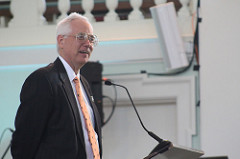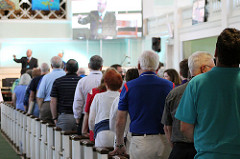Conference Treasurer James Berner discussed reasons for proposed changes to the conference’s health insurance plan during the laity session Thursday morning.
It was one of several topics brought up during the session, which was led by Conference Lay Leader Rich Shaffer.
The Board of Pensions, which oversees the conference health insurance plan, has proposed raising the deductible; establishing a policy that would not allow working spouses who have health care offered by their employer to be enrolled in the conference’s plan; changing the prescription drug co-payment; and increasing the hours one must work to be eligible to participate in the plan.
Berner, who serves as conference benefits officer and executive secretary of the Board of Pensions, said all of the proposed changes are expected to be voted on by the conference Friday.
The health insurance plan had a $2 million deficit last year. The proposals are designed to reduce that shortfall by shifting the cost of benefits from the conference to the participants.
“We cannot continue down the path we’re on,” Berner said.
The proposals generated numerous questions from the laity.
Berner said the conference’s Clergy Emergency Fund could be used to help ease the cost of increased healthcare costs. The fund is designed to help clergy and their families faced with medically related expenses that would create financial hardship to them or their family.
Active clergy families under appointment to the West Virginia Annual Conference or retired clergy families may request grants of up to $2,500 annually. The maximum amount of grants available in a lifetime is $7,500. These amounts were recently increased by the Board of Pensions.
One person questioned what would happen to a spouse who must leave the plan because their employer offers insurance, but the employer plan’s open enrollment period does not coincide with the conference plan’s enrollment period.
“We don’t want anybody to go without healthcare,” Berner said. “That is not the goal. The goal is to shift some of the costs to the people utilizing the plan.

“We would ask for documentation from the spouse’s plan as to when their open enrollment is” and, if needed, “we would provide coverage for that interim period.”
However, if the proposed change is approved, spouses who must leave the conference plan and learn that their employer’s plan has an open enrollment period before the end of this year, they will be expected to go ahead and enroll in their employer’s plan, Berner said.
Another person asked what would happen regarding insurance for children if a spouse must leave the conference’s plan.
It would be up to the family to decide under which plan they want their children covered, Berner said.
In response to another question, Berner pointed out that eligibility to participate in the conference plan would not be based on whether a spouse is a member of the conference. “It is based on whether the spouse has an employer who offers a plan.”
None of the recommendations impact the finances of local churches, Berner emphasized.
But if the expense side of the plan’s balance sheet is not rectified, “we’ll be forced to move to the income side,” Berner said. That could lead to a recommendation that premiums be increased.
“The number we’ve talked about is 20 percent,” he said. A 20 percent increase would total more than $600,000.
Any premium increase would impact local church budgets because churches are required to pay at least 70 percent of their clergy’s health insurance premiums (Some elect to pay more, up to 100 percent).
Therefore, $600,000 increase in premiums would require the conference’s churches to come up with at least $420,000 more than they currently pay.
“Our concern is, at the local church level, where does that money come from?” Berner asked.
He revealed that as of the end of May, “209 of our churches have not paid one penny toward their apportionment.” That’s $1.2 million in unfunded apportionments.
“If one-third of our budget is related to healthcare, that’s about $400,000 I don’t have to pay healthcare claims,” he said. “That’s the cash-flow problem we have right now. Hopefully that will catch up, as it always does…”
Also during the session, Conference Secretary Judith Kenaston explained one of the five proposed church constitution amendments voted on last year that was voted on again Thursday afternoon.
The proposal states that, “As the Holy Scripture reveals, both men and women are made in the image of God and, therefore, men and women are of equal value in the eyes of God.”
A re-vote was required because, due to a clerical error, some unapproved language was included in the proposed amendment that was sent to the conferences last year.
The outcome of the re-vote won’t be known for some time. That’s because it must be voted on by all of the annual conferences around the world.
(The amendment with the unapproved language was narrowly defeated last year. That has prompted some clergywomen and laity to wear buttons this week that say, “Nevertheless, She Preaches” or “Nevertheless, She Leads!”)